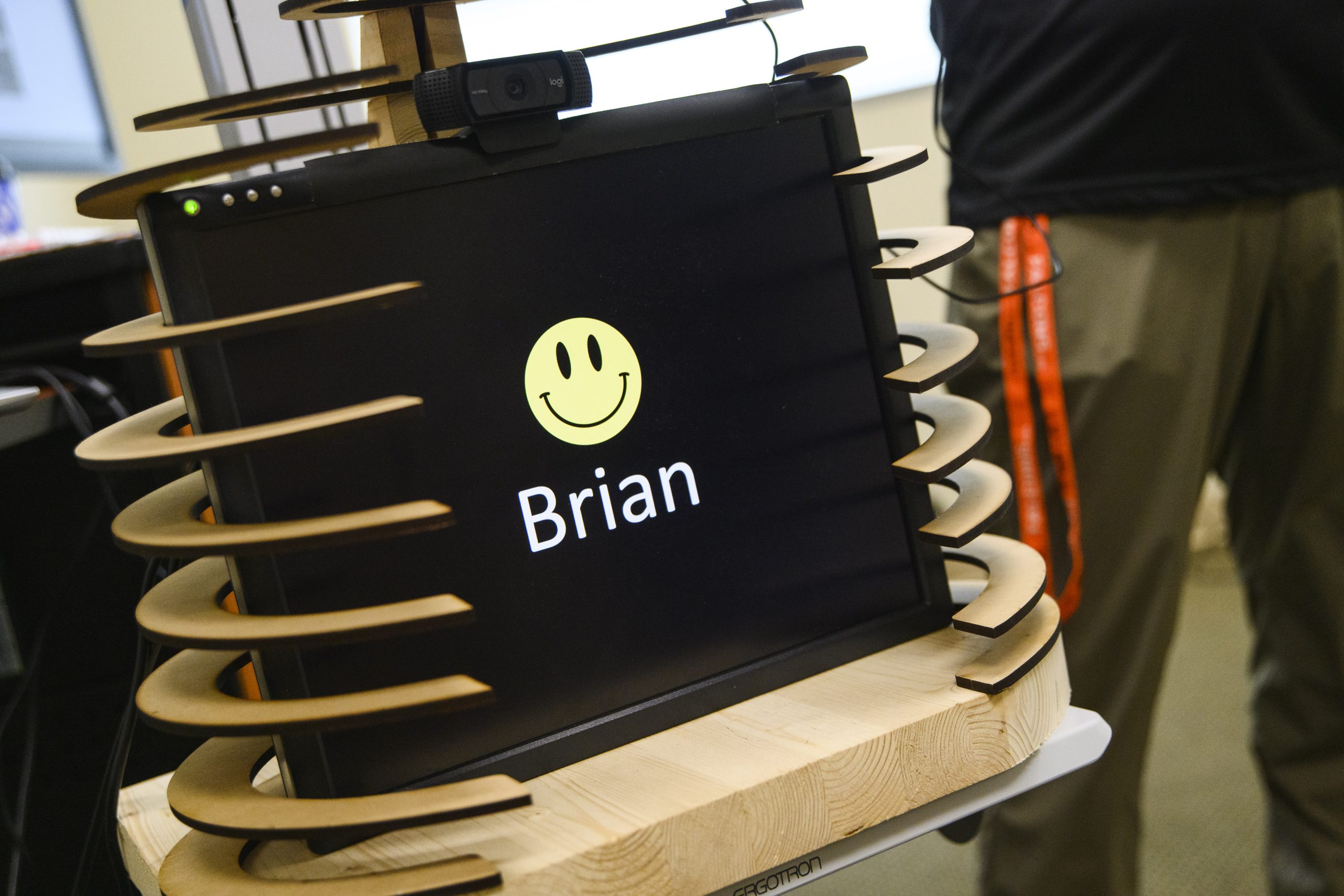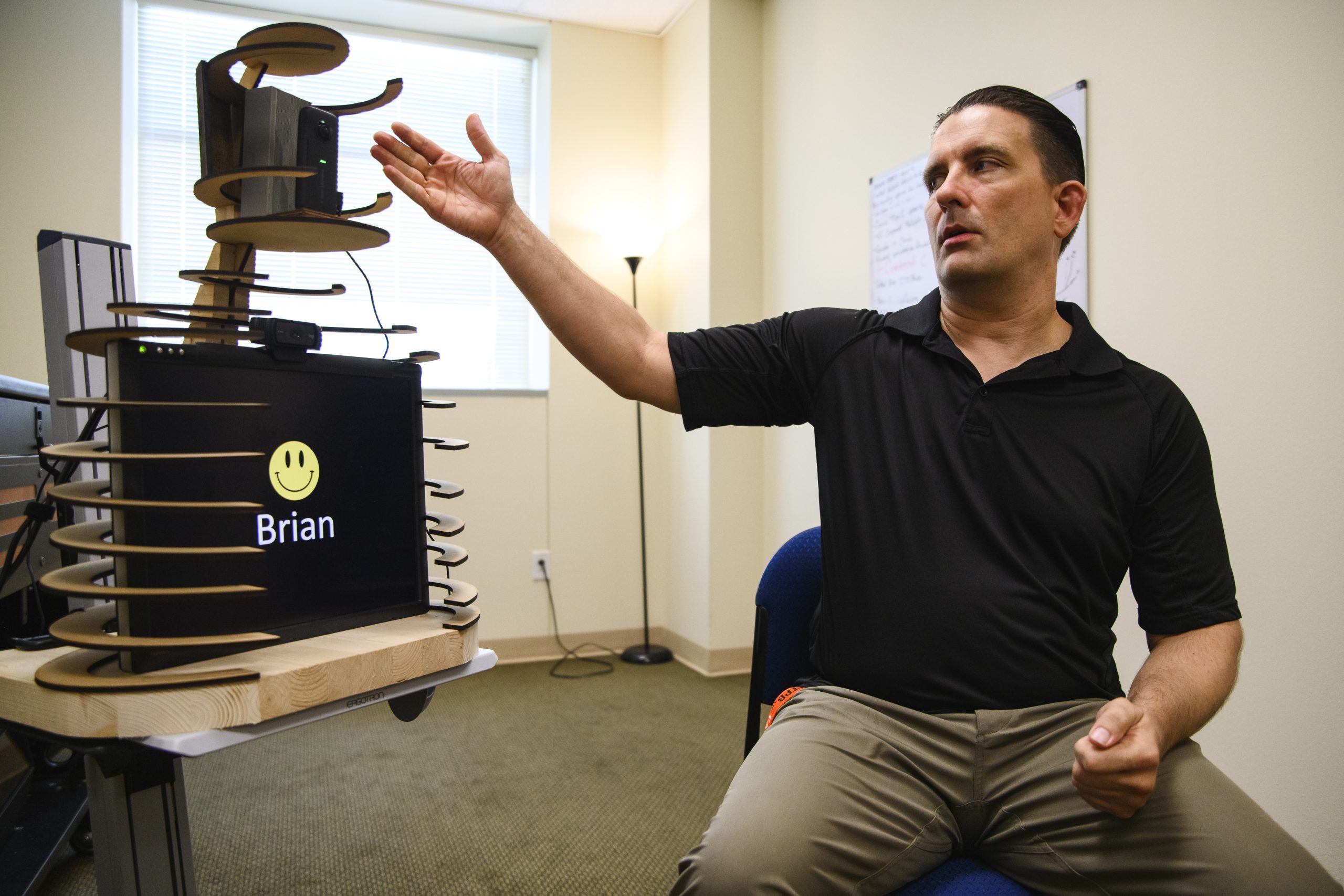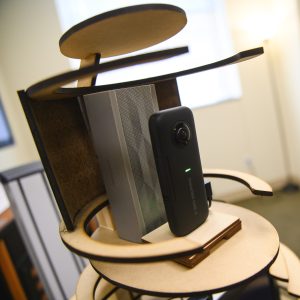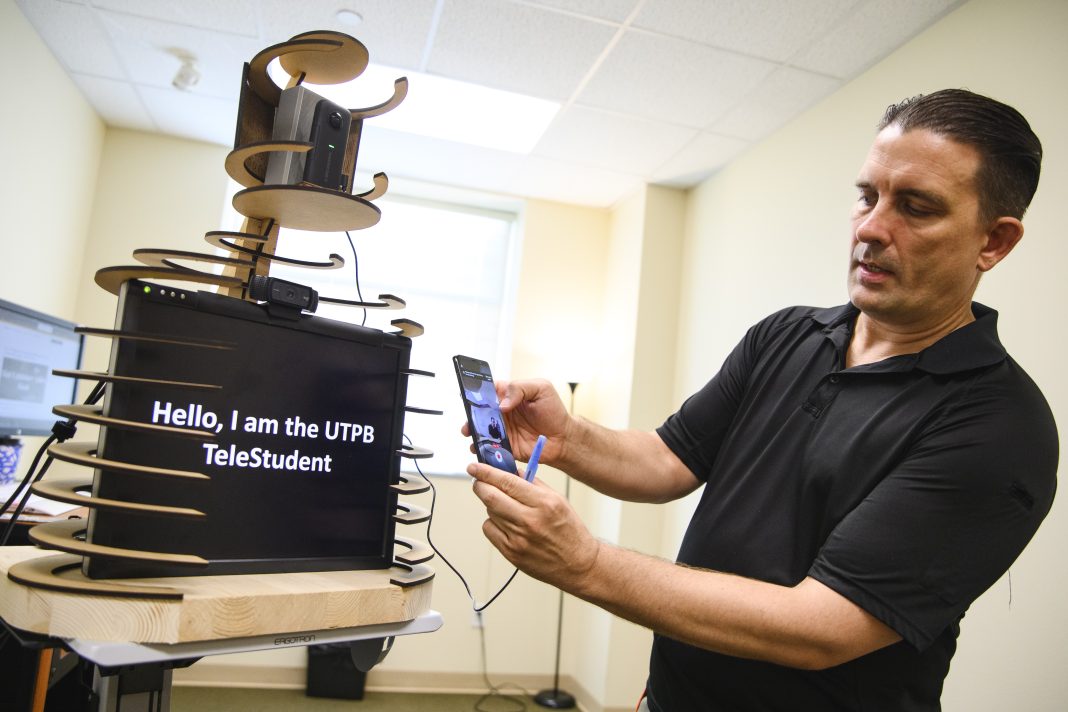To help faculty create a virtual environment that is more engaging, two University of Texas Permian Basin officials have made the IT TeleStudent.
TeleStudent is a skeleton-type robot that lives in the classroom and acts as a student.
Senior Instructional Technology Analyst Curtis Rogers said it can be put in lecture or small group mode and with its 360 camera, gives students a fuller view of the classroom. Many students can also connect at once.
“What they’ll be able to do is they can actually look around, either on their computer or through the headset, … the classroom and see their classmates. The reason it was given a body is to kind of give you a feel that you have someone else in the class with you,” Rogers said.

Brad Shook, vice president for Information Technologies, said what they are trying to do is give the faculty all the tools they need to make their classes interactive and interesting for students.
“If I’m sitting down in a class, we can actually lower it down so people at home will have the same perspective as they would if they were in the classroom,” Rogers said.
The screen will show if someone has a question.
“… It’s important because this one TeleStudent may actually be representing 10 remote students …,” Rogers said.
In this way, he added, teachers don’t have to teach differently for remote students.
If a student has a question, the professor could answer it as though the student was in the classroom.
“They can hear the lecturer, the instructor all the time but in order for them to speak they need to be in the small group mode,” Rogers said.
The remote students can talk to each other and the in-person students can talk to the TeleStudent in real time.

Shook said the idea came from Clark Moreland, lecturer of English and director of the Heimmermann Center for Engaged Teaching.
Shook said Moreland had a number of different ideas on how to engage remote students, so he approached the IT team and it went from there.
“How do you make the students feel like they’re not just talking to a web cam on top of a computer? Then … for the home student, how do you make them feel like they’re part of the class by giving them the freedom to look around at what they want to look at, especially with the 360 camera it’s a lot more like being in class because sometimes it’s just interesting to see who you’re in class with, or if somebody’s talking other than being stuck on a static camera looking forward,” Rogers said.
Rogers said there is a privacy shield for students who don’t want to be seen on camera.
All the technology being used for the TeleStudent was already in use at UTPB.
“The main thing about the TeleStudent is that it brings everything together all at once and that’s kind of why we’re really excited about it is because it does involve so many different things that we’ve had good success with up to this point,” Rogers said.
In this area, Shook said there are a lot of oilfield workers that want to go back to school and a lot of times they can’t physically go to class, but this way they can still connect and feel part of the group.

During the pandemic, he said they used Microsoft Teams when they were giving a synchronous class.
“… So if I’m not watching the chat box, it’s real easy to miss the question so that’s the reason we had this big screen, so now whenever they type it in, it’s big. I can see Curtis had a question and I’m not having to … go back to Teams checking …,” Shook said.
Using items that were already around at UTPB, and are likely around at many school districts, the TeleStudent was built in pieces. If they had worked solidly, it would have taken two weeks to construct, Rogers said.
Shook said the other thing they do in his department is making use of free software.
Rogers said they use Open Broadcaster Software, which a lot of streamers and gamers use.
Rogers said the technology can be duplicated “pretty handily.”
Once they go through the fall semester and get feedback from students, Shook said they might change or refine the model.
They have also used the technology to help people with social anxiety by making videos of going to a bank and opening an account, or making a deposit, for example, so they can familiarize themselves with that.
The technology can be shared with other institutions and school districts.
Shook said another exciting aspect of the TeleStudent project is the involvement of student workers who have helped build the frame, put it together and test it.
“ … That’s one of the things that our department really prides ourselves on is involving a lot of students (who we’re bringing in), (and letting) them have experience in these projects; work experience that they can put on their resume.”
“One of the things that’s really neat about Curtis’ department over here in ITS Productions is those student workers, by the time they’ve left, they have all kinds of production on their resume from 360 video to 2D modeling,” Shook said.
Shook said they started offering high school students internships last year.
“… Through working with ECISD and their CTE (Career and Technical Education) program, the students are actually here for a couple of hours every day … so they get (the) high school credit that they need, but then they’re getting experience here learning a lot of these skills. We’ve got them in our production department, the technology department and tech support. This next fall, we’re going to have them in our engineering department. We’re going to also have them over in the art building, so we’re really trying to help bridge that gap between our high schools and UTPB so that way our high school students can see what we have to offer and get some of that experience before they graduate high school,” Shook said.
Rogers said they have done quite a bit with escape rooms which are also getting used in a big way.
A member of the music faculty, Dan Keast, had gone to a music conference and they showed a static picture of some objects and you clicked on them randomly and that would take you to the next phase.
Ultimately, it wound up in a live Teams session where the student would play their instrument for Keast.
Rogers said this has created a lot of excitement among the faculty about 3D environments. They created a video of going around campus in a wheelchair so you can see what it’s like and the challenges faced.
Shook said another piece they are looking into is how to make the technology affordable for students.
“… I don’t know that we’ll ever see classes always virtual … but there are going to be situations where virtual is the most useful and it just brings that extra level. We want to be able to help get a cost-affordable solution so these students can now all participate in that 360 world and … get that experience and engagement and hopefully get excited about what they’re doing because now they get to do it in virtual reality,” Shook said.
Rogers said he’s done a lot “with gamifying a lot of this using technologies that the students already enjoy and bringing them into that, so hopefully it does enhance their experience with engagement in class.”
Shook said they had already done something similar with a display of ancient Mexican art owned by ECISD Chief Innovation Officer Jason Osborne.
Rogers and his student workers took 3D scans of a lot of the art and took 3D pictures and built a full package that a school can download. It includes all the information about the pieces.
“They can experience it in VR. They can print out the objects because it’s got 3D prints, so now they can do the full experience of the art gallery. They can touch it, they can feel it, they can do the 3D view of it, they can spin it in 3D, zoom in on it. It’s all the technology that they have,” Shook said.




